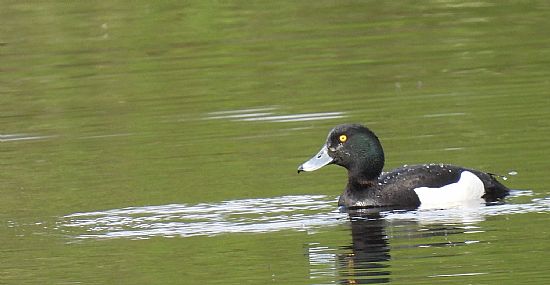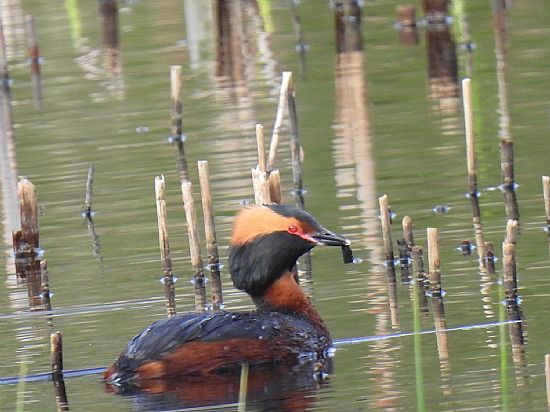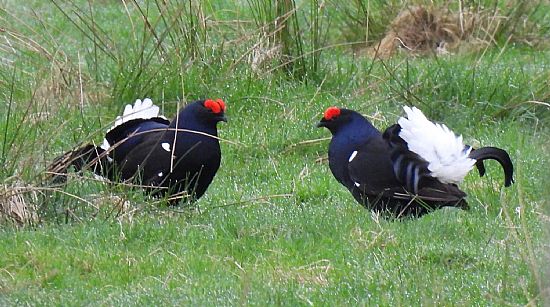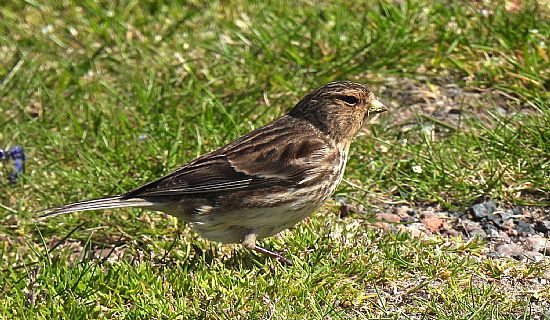Scottish Highlands, April 2024
Mark Finn
Photos: Charlie Cowan
April 27-May 4
April 27th: Roseisle, Easter Dalziel, Cromarty Firth, Chanonry Point
Daily 62 New 62 Running 62
Weather: Rather mixed with sunny spells and showers on a SE wind 7c-11c
I started the tour in Inverness and travelled along the A96 to Forres and then to Roseisle a forest area overlooking the Moray Firth. The commoner species were seen along the road with large numbers of gulls attending the seasonal pools around the pig farms. At Roseisle the vantage point is elevated and we quickly located Common Eider, Common and Velvet Scoters, Red-breasted Merganser and best of all a summer plumaged White-billed Diver. It was time to return to Inverness and pick up another client and a visit to Easter Dalziel. The habitat here is rough grassland, cereal fields and areas of bushes. On arrival we located the rare and localised Corn Bunting and heard Grasshopper Warbler and Reed Bunting calling from the sallow. Other species present included Common Buzzard, Eurasian Sparrowhawk, European Greenfinch, European Goldfinch and Yellowhammer. It was time to cross the Kessock Bridge and visit the rolling landscapes and habitats of the Black Isle. At Udale Bay the group located lingering Pink-footed Geese, Eurasian Oystercatcher, Eurasian Curlew, White Wagtail, Eurasian Wigeon and Eurasian Teal. All of these were spooked by a first year Peregrine Falcon hunting the waders including a single Common Redshank. Further down the road beyond Jemimaville a scan of the firth revealed Greater Scaup and rafts of Common Eiders. The back road via Eathie to Chanonry Point produced nothing of note apart from singing Willow Warblers. Chanonry Point was excellent today as the running current and rip tides attracted sprats and mackerel which in turn lured many birds. A careful scan of the birdlife revealed large numbers of Red-throated Divers, a single Black-throated Diver, Northern Gannet, Long-tailed Ducks, Black-legged Kittiwake, Common and Herring Gulls and within the flock a second year Iceland Gull, Common Guillemot and Razorbill.
Mammals: Brown Hare (1), Bottle-nosed Dolphin (1)

Male Tufted Duck
April 28th: Achanalt, Gairloch, Melvich, Loch Ewe, Mellon Charles, Laide, Gruinard Bay
Daily 79 New 30 Running 92
Weather: Sunny spells and showers on a cool SSE wind 4c-9c
Today I headed towards Wester Ross a vast area of Scotland with a small and dwindling population set among some of the finest scenery in Scotland. Our first stop was at Achanalt a large freshwater marsh bordered by mountains, moorland and birch woodland. By the viewing point we quickly found several singing Willow Warblers, calling Eurasian Bullfinch and European Robin. A look into the open waters revealed several species of breeding ducks including Mallard, Eurasian Wigeon, Eurasian Teal, Tufted Duck, a female Common Goldeneye and a pair of Whooper Swans. On muddy islands we located Ringed Plover, Common Redshank and Dunlin. To my surprise two female Black Grouse flew overhead and fleeting views of an adult White-tailed Eagle. On the loch edge a pair of Common Sandpipers. Further along the road the group encountered a pair of Wood Sandpipers, singing Common Snipe and flocks of Sand Martins which breed in riverside holes. A loch near Achnasheen produced Common Cuckoo, Northern Wheatear, Common Buzzard and calling Common Greenshanks. Next stop was Gairloch one of the few remaining areas where Gaelic is spoken on the Scottish mainland. A scan into Loch Gruinard added Great Northern and Black-throated Divers, Common Guillemot, Red-breasted Merganser, Rock Pipit, European Shag and the common gull species. I decided to visit Melvich an isolated crofting community on the coast overlooking the Western Isles. Not too much to report apart from European Stonechat, Rock Dove and Common Linnet along the road. Offshore large numbers of Great Northern Divers were congregating for their northbound migration along with a winter plumaged Black Guillemot. Loch Ewe was quiet today apart from Rock Doves and Greylag Geese. A visit to Mellon Charles had a pair of Little Grebes and Laide Jetty plenty of divers and gulls. I ended the day at Gruinard Bay overlook point where an adult White-tailed Eagle flew overhead a fitting end to the day.
Mammals: Red Deer (10), Wild Goat (2), Common Rabbit

Slavonian Grebe
April 29th: Nairn, Roseisle, Burghead, Lossiemouth, Loch Spynie, Alturlie, Ness Islands
Daily 86 New 19 Running 111
Weather: Variable with sunshine and showers on a NW-SE wind 8c-14c
This morning our first birding stop was the jetty at Nairn East Beach. The tide was out although conditions were calm and sunny with no wind. The usual sea-ducks and gulls were around so I headed towards Roseisle which is further east. On arrival we quickly located a White-billed Diver which was clearly a different bird from a few days ago. A scan of the sea added Red-throated Diver, Common and Velvet Scoters, Long-tailed Ducks and passing Northern Gannet, Sandwich and Common Terns. It was the time to visit Burghead with its harbour and granite houses. The harbour had Herring and Great Black-backed Gulls, Ruddy Turnstone, and the nearby cliffs Rock Pipit. A scan into the Moray Firth added rafts of Common Eider and flocks of northbound Long-tailed Ducks. At Lossiemouth the tide was low and sandy bars exposed which attracted Dunlin, Bar-tailed Godwit and many gulls. I decided to have lunch at Loch Spynie opposite the many bird feeders. Close views of Great Spotted Woodpecker, Great Blue and Coal Tits, Common Chaffinch, European Goldfinch, Eurasian Siskin and in the background singing Blackcap and Willow Warbler. A short walk towards the hide had a singing Common Chiffchaff. From the hide we had views of Gadwall, Mallard, Common Coot and Little Grebe. Next was one of the many pig farms with seasonal lagoons. This particular one was good for Whooper Swan, Northern Pintail, Eurasian Teal, hundreds of gulls. It was time to head east back to Inverness and a visit to Alturlie a small wetland where the group heard Common Moorhen but little else. The finale was Ness Islands in Inverness where the river held Common Merganser and a showy White–throated Dipper. The trees had the common woodland birds and at least three Eurasian Bullfinches and Long-tailed Tit. On our way back to Cygnus House a newly sown field held in excess of a hundred European Golden Plovers in summer plumage a fitting finale to the day.
Mammals: Brown Hare (2), Common Rabbit (2)

Male Black Grouse lekking
April 30th: Corrimony, Novar Estate, Portmahomack, Embo, Loch Fleet, Brora, West Langwell
Daily 84 New 8 Running 119
Weather: Cloudy with sunny spells on a NE wind 3c-17c
An earlier departure time was in order to arrive at Corrimony at dawn. Outside the house we heard a singing Eurasian Skylark and literally up the road a Western Barn Owl sitting on a post. At Corrimony we met up with Simon the warden and proceeded onto the reserve and the first lek site. Black Grouse was quickly recorded at close range and gave us excellent views. Also present were Eurasian Curlew, Northern Lapwing, Common Cuckoo, Mistle and Song Thrushes, Common Stonechat, Meadow Pipit, Lesser Redpoll and two Scottish Crossbills. On our return a Great Spotted Woodpecker, Common Kestrel, Tree Pipit, Eurasian Siskin and Yellowhammer. Breakfast was taken in Alness followed by a visit to the Novar Estate. A walk around the lower area gave us views of Common and Scottish Crossbills which showed well feeding in a native pine tree. Portmahomack is located in a sheltered arm of the North Sea where we witnessed the pre-migration of Common Scoter and Long-tailed Ducks and dozens of Red-throated Divers Careful scanning of the flock revealed a male Greater Scaup and Northern Gannets and on exiting a Western Osprey sitting on a nest close to the road. Embo is on the same arm and held similar birds whilst Loch Fleet gave us views of White Wagtail, Red-breasted Mergansers and Common Sandpipers. Brora is further north along the North Sea coast where the wind was strong and onshore. On a rocky area Whimbrel resting on their northward migration. Our last stop was the road towards West Langwell with sightings of an adult White-tailed Eagle being mobbed by two Northern Ravens and a pair of Whooper Swans on a distant loch.
Mammals: Brown Hare (1), NA Grey Seal (40), Red Deer (C),

Red-legged Partridge
May 1st: Cairngorm, Loch Morlich, Feshiebridge, Findhorn Valley, Farr Road
Daily 68 New 5 Running 124
Weather: Sunny spells followed by cloudy conditions on a SE wind 8c-16c
Travel down the A9 this morning with a visit to Cairngorm and the upper and lower car parks. In both areas bird life was low apart from a calling Red Grouse, Willow Warblers and Northern Wheatears. I then visited Loch Morlich where Common Goldeneye and Common Merganser were observed on the loch itself. On the loch edge a few pairs of Common Sandpipers, Black-headed and Common Gulls. It was to be a tough day for bird sightings as a visit to Feshiebridge revealed that a lot of the forest had been damaged during winter storms. A walk on the lower path added singing Tree Pipits and the commoner woodland birds. No sign of the Speyside specialties today. It was time to visit the Findhorn Valley where the river held White-throated Dipper and the road pairs of Red-legged Partridges. On the grass fields we watched Northern Lapwing, European Golden Plover and Eurasian Curlew. At the end of the road the first House Martins of the spring calling loudly and flying around the buildings. On the cliffs we could hear a singing Ring Ouzel but it eluded us.
Mammals: Brown Hare (3), Mountain Hare (1), Red Deer (C), Roe Deer (1), Pine Marten (1)
May 2nd: Orrin, Strathpeffer, Forsinard, Sandside Bay, Scrabster, Dunnet Bay, St John’s Loch, Dunnet Head
Daily 87 New 8 Running 132
Weather: Mainly sunny with spells of cloud on a SE wind 8c-18c
Our first birding stop today was the silver birch woods at Orrin. On arrival we quickly located Willow Warbler, Common Chiffchaff, Lesser Redpoll and the first returning Wood Warblers of 2024. Strathpeffer is nearby and the lochans held Little and horned Grebes, Tufted Duck, Mallard and Common Coots. It was time to head north towards Brora and then Glen Loth which leads into the vast Flow Country of Sutherland. Along the way we located Tree Pipit, Common Stonechat and a pair of Eurasian Bullfinches which looked totally out of place. At Forsinard I parked up where we could look over a large area of moorland and forest. This eventually paid off as a male Hen Harrier was located in flight and hunting birds within the area. Sandside Bay was next on the agenda which adjoins the Pentland Firth a stretch of water which separates the Scottish mainland from the Orkney Islands. The beach held migrant Whimbrel and Ringed Plovers, Pied and White Wagtails and several Rock Pipits. Before we reached Thurso a male Eurasian Sparrowhawk was seen with prey. A short diversion to Scrabster added Black and Common Guillemots, Common Eider and Herring Gull to the day list. Dunnet Bay had similar birds plus a mixed flock of Common Scoter and Long-tailed Ducks. The best was to come when at least Arctic Skuas starting attacking Sandwich Terns in flight. On the shore Dunlin, Ruddy Turnstone and Ringed Plover were seen. It was good to see that St John’s Pool was open to the public again with viewing possible from the public hide. Careful scanning rewarded the group with sightings of Gadwall, Northern Shoveler, Common Moorhen and at least three Black-tailed Godwits of the Icelandic race. Last stop was the cliffs at Dunnet Head and its seabird colonies. Northern Fulmar and Atlantic Puffin were seen among the various auks and gulls. A return was made to the town of Thurso where we stay for the night.
Mammals: Brown Hare (2), NA Grey Seal (2), Red Deer (C), Common Rabbit (C), Roe Deer (1)

Twite
May 3rd: Broubster Leans, Bettyhill, Hope Valley, Balnakiel, Lairg and Loch Shin, Bonar Bridge
Daily 83 New 5 Final 137
Weather: Sunny with a SSE wind 12c-21c
Our day commenced with a visit to Broubster Leans which is west of Thurso. This large expanse of rough grassland, lochs and marshes is attractive to a wide range of birds. A careful scan of the area revealed a pair of Hen Harriers, hunting Short-eared Owl, Osprey, Common Buzzard, Whooper Swans, European Golden Plovers, a reeling Grasshopper Warbler and displaying Common Snipe and Northern Lapwings. Further west is the village of Bettyhill where the bays and river afford refuge from the prevailing westerly winds. The bay held Red-throated and Great Northern Divers, Red-breasted Merganser, Common Guillemot and Razorbill. On the beach we watched returning Arctic and Sandwich Terns whilst the river edges attracted Greenshank, Common Sandpiper and Common Linnets feeding on dandelion seeds. Hope Valley was next on our agenda with Common Cuckoo and Common Stonechat in the rougher ground with bushes. Eventually we located a pair of Golden Eagles which gave us a great display as they hunted along the cliffs for hares and other prey. It was time to visit Durness and Balnakiel Bay in the extreme NW of Sutherland. The sea held Common Eider and Black Guillemot and the stone walls nesting Rock Pipit and Northern Wheatear. A highlight was Twite nesting in the older part of the church yard giving us exceptional views. A walk inland to the marsh area was productive for Eurasian Wigeon, Eurasian Teal, Northern Shoveler and Gadwall all scarce breeding birds, Whooper Swan, Pied and White Wagtails and singing Sedge Warblers although the latter kept hidden in cover. It was time to head south towards Lairg and Bonar Bridge through spectacular scenery. The commoner birds were observed en route.
Mammals: Red Deer (C), Common Rabbit (C), Roe Deer (6)

